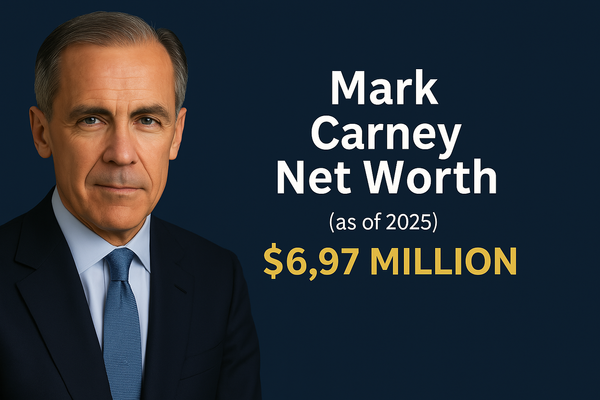Mark Carney vs Poilievre: Which Economic Vision Will Shape Canada's Future? [2025]
The latest mark carney news emphasizes a remarkable political showdown that shapes Canada's economic future. Carney's credentials stand out as the former Governor of both the Bank of Canada during the 2008 crisis and the Bank of England during Brexit. Recent polls indicate 60% of Canadians believe a Carney-led Liberal government would serve the country best. Poilievre's strong support remains solid in the Prairie provinces.
Their economic visions reveal stark differences. Poilievre advocates a 2.25 percentage point tax cut on the first $55,867 of income, which could save workers about $900. Carney's approach offers a more modest 14% tax rate proposal that would cost $6 billion in revenue. His plan aims to achieve balanced budgets within three years. Canadian voters face a clear choice between two distinct economic paths as they look toward 2025.
Fiscal Frameworks: Operating vs. Capital Budgets
"The separation of current and capital budgets permits the executive and legislative branches to present a partial picture of fiscal policy that conceals the aggregate growth of public expenditure." — William Niskanen, American Economist
Canada's economic debate centers on a fundamental disagreement about budget frameworks. Recent [mark carney news](https://www.conservative.ca/carney-cooks-the-books/) shows his plan to transform federal finances through a dual-budget system that divides operating expenses from capital investments.
Carney's dual-budget approach explained
The proposed budget split creates two distinct components. Carney pledges to balance within three years an operating budget that covers ongoing government expenses. A capital budget would handle investments with a modest deficit. The plan maintains pension benefits, child benefits, and transfers to provinces and territories. Capital investments would support infrastructure projects, housing initiatives, and Canadian-made military hardware. New legislation would strengthen the Parliamentary Budget Officer's resources and oversight to ensure accountability.
Poilievre's criticism of 'cooking the books'
Conservative leader Poilievre blasts Carney's proposal as "cooking the books." He claims this "sneaky accounting trick" aims to hide billions in Liberal spending from budget records. Current accounting rules already amortize capital investments properly based on accepted principles, according to Poilievre. His team references Alberta's past attempt to separate operating and capital expenses, which they say created confusion and reduced transparency. Poilievre promotes a "dollar-for-dollar law" that requires matching every new spending dollar with savings.
Expert opinions on budget transparency
Financial experts remain divided on these proposed frameworks. Former parliamentary budget officer Kevin Page observes that both Carney and Poilievre seem ready to deficit-finance their tax-cut promises early on. The C.D. Howe Institute's yearly fiscal transparency report raises red flags about delayed fiscal document releases, giving recent federal budgets poor grades for clarity. Economists caution that defining "investment" versus "spending" can become subjective and potentially manipulated. Alberta's similar capital budgeting approach in the early 1900s led to financial troubles, ultimately resulting in debt default during the 1930s.
This budget framework debate goes beyond accounting priorities and raises crucial questions about fiscal transparency and Canada's long-term economic vision.
Tax Relief Proposals: Who Benefits Most?
Major party leaders showed competing tax relief plans as they fight to win Canadian voters. Their proposals highlight completely different ways of managing the economy.
Poilievre's 2.25% tax cut on first bracket
The Conservative platform focuses on a big tax cut for the lowest income bracket by reducing rates from 15% to 12.75%. Poilievre's plan would save an average worker earning CAD 79,421.53 about CAD 1,254.02 each year. Two-income households would benefit by CAD 2,508.05 annually. This means a 15% reduction in income taxes for typical workers. The cost of this proposal is steep - CAD 9.75 billion yearly during the first two years, which would grow to CAD 19.51 billion per year once fully implemented by 2027-28. Poilievre says his government would pay for these cuts by "eliminating government waste" and "cutting the federal bureaucracy".
Carney's 1% reduction strategy
mark carney news presents a smaller-scale approach. The Liberal plan would cut the lowest tax bracket by just one percentage point, from 15% to 14%. Eligible tax filers would save about CAD 574.06 yearly, while two-income families could get up to CAD 1,149.52. The Parliamentary Budget Officer estimates Carney's proposal would cost around CAD 8.22 billion yearly, about half of what the Conservative plan would cost. The Liberals say their tax cut would help more than 22 million Canadians, mostly middle and low-income earners.
Impact on different income levels
Both parties present these cuts as help for ordinary Canadians, but economic experts point out uneven benefits across income groups. David Macdonald from the Canadian Center for Policy Alternatives calculates that Canadians below the poverty line would get just CAD 15.33 under the Liberal plan and CAD 34.83 from the Conservatives. This happens because low-income earners already use various credits that reduce their taxable income substantially. So changes to the lowest tax bracket help very little.
Economist Trevor Tombe's analysis shows about two-thirds of tax relief benefits would go to people earning between CAD 41,800.81 and CAD 125,402.42. On top of that, since both plans cut the first bracket rate that applies to everyone, high-income earners also get the maximum dollar benefit. Critics, especially from the NDP, say both proposals help wealthier Canadians more than those who need it most.
Government Spending Priorities: What Gets Cut?
Spending cuts have become a central point of conflict as party leaders show different visions for Canada's fiscal future. The debate goes beyond just the amount of cuts and focuses on which specific programs should be reduced.
Poilievre's targeted program eliminations
The Conservative leader has clearly identified his targets for elimination. Poilievre promises to eliminate the housing infrastructure fund and housing accelerator fund, cut CBC funding, close the Canadian Infrastructure Bank, and make significant cuts to foreign aid. His plan also aims to reduce the public service size and limit external contractor use. Past Conservative governments cut national childcare programs, but Poilievre has made it clear he will keep "transfers to people and provinces". He has criticized dental care programs that have helped more than a million applicants. His economic strategy follows a simple rule - ministers must cut one dollar of spending before they can spend another.
Carney's pledge to maintain social transfers
Mark Carney takes a different path to manage spending. He guarantees to protect transfers to individuals, which cover pensions, elderly benefits, employment insurance, child benefits, GST/HST credits, and disability savings grants. He also commits to keep provincial and territorial transfers like equalization payments, the Canadian Health Transfer, and Canada Social Transfer. His strategy to cut costs focuses on reducing government spending growth and setting limits on public service size. Programs like childcare, dental care and pharmacare will stay in place.
Infrastructure and defense spending differences
Both leaders share common ground on certain spending increases. They support higher infrastructure and defense spending, though their funding approaches differ. Carney wants to speed up investment in Canada's armed forces significantly with new submarines, icebreakers, and military pay raises. His infrastructure plan promises faster approvals - federal regulators would need to finish national interest project reviews in two years instead of five. Poilievre leans toward privatization and fewer regulations, while Carney believes in government-led investments to "maximize job creation".
Economic Response to Trump's Tariff Threats
"Trump's influence has transformed Canadian politics, turning a once predictable election into an unpredictable showdown." — Marci Surkes, Former policy advisor to Justin Trudeau
Trump's tariff threats have tested Canada's economic strength, showing clear differences in how both leaders would handle international trade challenges.
Carney's international finance experience
Recent mark carney news shows his plans for a CAD 2.79-billion "strategic response fund" to help workers affected by U.S. tariffs. His background as former Governor of the Bank of Canada and Bank of England shapes his perspective through years of international financial expertise. He spoke at the Ambassador Bridge about Trump's trade war that threatens "hundreds of thousands of Canadians who just want to earn a good paycheque". His government has responded to possible economic damage with counter-tariffs on CAD 83.60 billion worth of U.S. goods. They might expand these to cover CAD 215.97 billion in American products if the tariffs continue.
Poilievre's approach to US-Canada relations
Poilievre has expressed a "Canada First" policy with three key steps to address trade tensions. His first step suggests retaliatory tariffs on American goods in a specific order: goods Canada can produce, goods Canada doesn't need, and goods available from other sources. Unlike Carney, he believes counter-tariffs shouldn't become "a cash cow for the government" and promises that "almost every penny collected should go to tax cuts" instead of new government spending. Poilievre focuses on building economic independence by removing interprovincial trade barriers. Economist Trevor Tombe estimates this could boost Canada's economy by up to 7.9% or CAD 278.67 billion annually.
Potential economic impacts of different strategies
Economic challenges face both strategies. The Conference Board of Canada projects GDP would drop 1.3% below baseline with tariffs, while exports would fall by 8.0% and unemployment would rise to 6.9%. The auto industry remains most at risk, facing a possible 57.4% export decline. The Canadian Chamber of Commerce predicts even worse outcomes – a 2.6% GDP drop (about CAD 108.68 billion) costing each Canadian roughly CAD 2,647.38 yearly. Inflation would rise by 0.7 percentage points as the Canadian dollar weakens to 64.4 cents against the USD. Both leaders want to reduce these effects while recognizing, as Carney said, "We have learned there is an unpredictability to U.S. trade policy".
Comparison Table
Economic Aspect | Mark Carney | |
|---|---|---|
Tax Cut Proposal | 1% reduction (15% to 14%) | 2.25% reduction (15% to 12.75%) |
Annual Tax Savings per Worker | $574.06 | $1,254.02 |
Cost to Government | $8.22 billion annually | $19.51 billion by 2027-28 |
Budget Framework | Dual-budget system (separate operating and capital budgets) | Single unified budget with dollar-for-dollar law |
Deficit Timeline | Balance operating budget within 3 years | Not mentioned |
Social Transfer Position | Preserve all transfers to individuals and provinces | Maintain "transfers to people and provinces" |
Program Cuts | Cap public service size, slow government spending growth | Cut CBC, Infrastructure Bank, foreign aid, reduce public service |
Infrastructure Approach | Government-catalyzed investments, 2-year approval timeline | Privatization and reduced regulation |
Trump Tariff Response | $2.79B strategic response fund, counter-tariffs up to $215.97B | Targeted retaliatory tariffs, revenue directed to tax cuts |
Provincial Trade | Not mentioned | Remove interprovincial trade barriers |
Conclusion
Mark Carney and Pierre Poilievre show Canadians two very different economic paths for 2025 and beyond. Carney promotes a measured approach through his dual-budget system and modest 1% tax reduction. Meanwhile, Poilievre pushes for aggressive tax cuts and major program eliminations.
Both strategies come with most important trade-offs, according to economic data. The promise of a balanced operating budget within three years by Carney provides fiscal stability. His $8.22 billion tax cut plan gives workers smaller immediate benefits. The deeper tax reductions proposed by Poilievre would save average workers $1,254.02 each year but would cost $19.51 billion by 2027-28.
Their contrasting philosophies become clear in responses to Trump's tariff threats. Carney uses his international finance background to suggest a $2.79-billion response fund. Poilievre focuses on economic independence through interprovincial trade and targeted retaliation.
Canadian voters must choose between Carney's internationally-focused, measured approach and Poilievre's aggressive domestic reforms. Polls favor Carney now, but economic conditions and international pressures will without doubt shape voter priorities as election day approaches. Canadians must decide which economic vision better serves their immediate needs and secures long-term prosperity.
FAQs
Q1. What are the main differences between Mark Carney's and Pierre Poilievre's tax cut proposals? Carney proposes a 1% reduction in the lowest tax bracket (from 15% to 14%), costing $8.22 billion annually and saving workers about $574 per year. Poilievre advocates for a 2.25% cut (from 15% to 12.75%), costing $19.51 billion by 2027-28 and saving workers approximately $1,254 annually.
Q2. How do Carney and Poilievre differ in their approach to government spending? Carney pledges to maintain social transfers and slow government spending growth, while capping public service size. Poilievre proposes specific program cuts, including defunding the CBC, closing the Canadian Infrastructure Bank, and reducing foreign aid, along with shrinking the public service.
Q3. What are the key features of Carney's dual-budget system? Carney's dual-budget system separates operating expenses from capital investments. The operating budget, covering ongoing government expenses, would be balanced within three years, while the capital budget for investments would carry a modest deficit.
Q4. How do the two leaders plan to respond to potential U.S. tariffs? Carney proposes a $2.79 billion strategic response fund to support affected workers and threatens counter-tariffs on up to $215.97 billion in American products. Poilievre advocates for targeted retaliatory tariffs and pledges to direct any tariff revenue to tax cuts rather than government spending.
Q5. What are the projected economic impacts of U.S. tariffs on Canada? Economic forecasts suggest significant negative impacts from U.S. tariffs. The Conference Board of Canada projects a 1.3% GDP decline below baseline, with exports reduced by 8.0% and unemployment rising to 6.9%. The Canadian Chamber of Commerce forecasts even more severe impacts, including a 2.6% GDP contraction and increased inflation.


